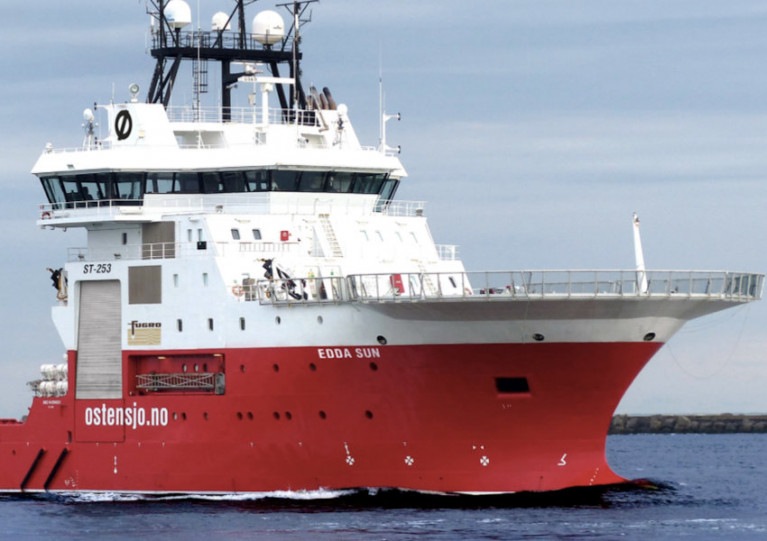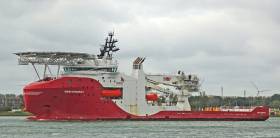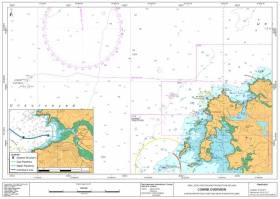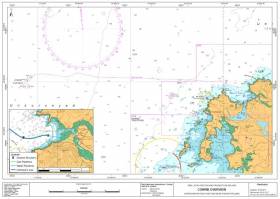Displaying items by tag: Corrib Gas field
Marine Notice: Umbilical Rock Placement at Corrib Gas Field
Vermilion Exploration & Production Ireland Limited is carrying out a maintenance campaign at the Corrib Gas Field subsea infrastructure, with spot rock placement along the main umbilical.
Works were due to commence in the field on Sunday 25 June to last for around three days, subject to weather and operational constraints.
The vessel FFPV Stornes (Callsign PCKX) is undertaking the subsea scope of work during day and night hours, displaying all appropriate lights and signals while carrying out rock placement activities using a fall-pipe system and associated acoustic survey equipment.
All equipment will be vessel and/or remote operated vehicle (ROV) mounted. Visual and acoustic surveys will be conducted by means of vessel- and ROV-mounted cameras and sensors. The work vessel will be listening on VHF Channel 16 throughout the project.
Coordinates and a map of the survey area as well as contact details can be found in Marine Notice No 36 of 2023, attached below.
The Canadian-based operator of the Corrib gas field has increased its stake in the north Mayo project to 56.5 per cent.
Vermilion Energy says it is now “the largest provider of domestic natural gas in Ireland” after confirming acquisition of the Equinor ASA stake in the project.
The gas field’s revenues benefited from a 61 per cent increase in gas prices last year, according to the Vermilion Energy annual report for 2022.
In a statement, the Canadian energy company said the acquisition “adds an incremental 36.5% interest in the Corrib Natural Gas Project, increasing Vermilion's operated interest to 56.5%”.
The company said it had entered into an agreement with Equinor ASA in November 2021 to acquire its stake for US$434 million ($556 million), “before closing adjustments and contingent payments”.
It said net purchase price was approximately $200 million.
This net price was after “adjusting for the interim free cash flow between the effective date and closing date inclusive of Vermilion's estimates of European windfall taxes based on information released to-date on how it will be implemented in Ireland, the contingent payment and other closing adjustments”, the company said.
The acquisition “adds approximately 7,000 boe/d of premium-priced, high netback, low emission European natural gas production, further strengthening Vermilion's international portfolio”, it said.
The company described Corrib as a “world-class, low emission, natural gas facility, comprised of a conventional gas field located 83 kilometres off the northwest coast of Ireland and a state of the art gas processing plant onshore Ireland”.
“The facility has a gross plant capacity of approximately 350 million cubic feet of natural gas per day and is currently producing 115 million cubic feet of natural gas per day, representing approximately 20% of Ireland's natural gas consumption and 100% of Ireland's domestic gas production,”it said.
It said that since taking over operatorship in 2018 from Shell, Vermilion has “reduced costs and increased uptime while maintaining world-class safety and environmental performance”.
Corrib Gas Project Profits Should be Ring-Fenced for North Mayo - TD
A Mayo TD has called for windfall tax on profits of the Corrib gas field to be ring-fenced for the Erris region of north Mayo.
Sinn Féin TD Rose Conway Walsh said the company trebled profits in the first six months of 2022 to an estimated €560 million.
As the Connacht Telegraph reports, this puts it on course for €1 billion of profits for the year, she said.
The Belmullet-based TD: "The design of the windfall tax, as it is stated by the Council of the European Union, is far from perfect, as it lets the company keep the vast majority of the windfall profits.
"They keep all of their normal profits, plus an extra 20%, and then they keep 77% of the windfall profits over and above that,” she told the newspaper.
"It would be an important gesture for the people of Mayo and Belmullet, particularly for the likes of Belmullet Community Hospital and the R312,”she said.
Read more in the Connacht Telegraph here
Marine Notice: Pipeline Inspection and Subsea Structure Inspection at Corrib Gas Field
Vermilion Exploration & Production Ireland Limited will carry out a maintenance campaign at the Corrib Gas Field’s subsea infrastructure from next weekend.
The works are due to commence in field next Sunday 14 August and last for up to 21 days, weather allowing. Maintenance works, including pipeline and subsea structure inspection, will take place at Latitude 54° 20’ 20.413” N, Longitude 11° 03’ 30.769” W.
All works will be undertaken by the vessel EDT Jane (callsign 5BXW3). All equipment used will be vessel and/or remote operated vehicle (ROV) mounted. Visual and acoustic surveys will be conducted by means of vessel- and ROV-mounted sensors.
The vessel will be listening on VHF Channel 16 throughout the project.
Maps of the survey area and contact details are included in Marine Notice No 50 of 2022, attached below.
Marine Notice: Corrib Gas Field Pipeline Inspection & Maintenance Works
Vermilion Exploration & Production Ireland Limited will begin a maintenance campaign at the Corrib Gas Field subsea infrastructure from tomorrow, Friday 1 October.
The maintenance works at the Corrib gas field will take place at Latitude 54° 20’ 20.413” N, Longitude 11° 03’ 30.769” W and are due to last for up to 21 days.
The Edda Sun (callsign LARF7) will undertake the subsea scope of work. All equipment used will be vessel and/or remotely operated vehicle (ROV) mounted. The vessel will be listening on VHF Channel 16 throughout the project.
Mariners are asked to note that visual surveys will be conducted along the Corrib pipelines and umbilicals using vessel mounted ROVs and their associated camera booms. No acoustic survey equipment will be utilised during the campaign.
For further information on the survey area, see Marine Notice No 51 of 2021 which can be downloaded below.
Corrib Gas Field Maintenance Works From Next Weekend
Vermilion Exploration & Production Ireland Limited is scheduled to carry out maintenance work at the Corrib subsea infrastructure from next Sunday 13 June.
The maintenance work at the Corrib Gas Field will take place at Latitude 54° 20’ 20.413” N, Longitude 11° 03’ 30.769” W and is expected to take up to five days to complete.
The Edda Sun (Callsign LARF7) will undertake the subsea scope of work. All equipment used will be vessel- and/or ROV-mounted. The vessel will be listening on VHF channel 16 throughout the project.
Further information on the survey area is available Marine Notice No 36 of 2021 which can be downloaded below.
Upcoming Electrical Fault-Finding Works At Corrib Gas Field
Mariners in the vicinity of the Corrib Gas Field are advised of electrical fault-finding works at the field’s subsea infrastructure set for later this month.
Works conducted from the Edda Sun (callsign LARF7) will begin on or around next Friday 18 September and will last for up to 10 days. The work vessel will be listening on VHF channel 16 throughout the project.
Details of co-ordinates of the search and repair area are included in Marine Notice No 39 of 2020, which is attached below.
#MarineNotice - Shell E&P Ireland Limited has begun a campaign of inspection of the Corrib Gas Field pipeline and associated infrastructure with repair and maintenance as required. Engineering tasks are also scheduled for well P3.
The near shore pipeline inspection was scheduled to commence in mid July and last for approximately 10 days. The offshore pipeline and subsea structure inspection along with the P3 work is due to commence in early August 2018 and last for approximately 14 days.
Visual and acoustic surveys will be conducted by means of sensors mounted on vessels and Remote Operated Vehicles (ROV) and cameras located on attendant survey vessels, ROVs and towed side scan sonar.
The near shore pipeline and umbilical sections will be inspected from the nearest point accessible inshore at high tide progressing to offshore until a suitable overlap with the offshore inspection is achieved.
The offshore inspection will commence at the Corrib field location and will continue towards shore until the vessel is required, on Marine Mammal Observer (MMO) advice, to relocate to the inshore inspection extent at safe navigation depth limit.
The vessel An Gearoidin (Callsign EIDL6) will undertake the near shore survey scope. All the equipment used will be vessel deployed. The Macbel and Blue Eagle will provide safety and welfare support to An Gearoidin.
The Siem Stingray (Callsign LAFP8) will undertake the deep water surveys and the subsea facilities maintenance and inspection. It will also carry out the P3 rectification work. All equipment used will be vessel and/or ROV mounted. All vessels will be listening on VHF Channel 16 throughout the project.
Full details of relevant co-ordinates and a map of the survey area are included in Marine Notice No 31 of 2018, a PDF of which is available to read or download HERE.
Marine Notice: Offshore Rock Placement In Corrib Gas Field
#MarineNotice - Shell E&P Ireland advises that it will commence rock placement works between two wells in the Corrib Gas Field before the end of this month.
These works, which are expected to be completed by the middle of August, come after a recent pipeline survey and inspection that included the installation of a replacement subsea control umbilical.
The latter requires the placements of rocks for protection within the 500m safety zone along the corridor between wells P1 and P5.
There will also be installation of rock protection/stabilisation at areas of known exposure or excess spanning along both the infield flow and control lines as well as the 20” pipeline and main control umbilical between the gas field and landfall at Glengad.
Works will be carried out by the DP Fall Pipe Rock Placement Vessel Seahorse (Callsign PCAP), which will be listening on VHF Channel 16 throughout.
Full co-ordinates of the rock placements are detailed in Marine Notice No 31 of 2017, a PDF of which is available to read or download HERE.
#MarineNotice - Shell E&P Ireland advises that inspection and engineering tasks will take place at the Corrib Gas Field and related offshore infrastructure from this month.
The work, due to commence in mid June and last for around 40 days, will include inspection of the offshore pipeline and subsea structure, inspection of the near shore pipeline, an umbilical lay at well P5, and a pipeline integrity test via ‘intelligent pig’ survey.
Visual and acoustic surveys will be conducted by means of vessel- and ROV-mounted sensors and cameras located on attendant survey vessels, ROVs and towed side scan sonar.
The Subsea Viking (callsign LJJL3) will undertake the deep water surveys and the subsea facilities maintenance and inspection. It will also carry out the umbilical lay and the intelligent pigging operation. All equipment used will be vessel and/or ROV mounted.
The An Gearoidin (callsign EIDL6) will undertake the inshore survey scope. All the equipment used will be vessel deployed.
Both vessels will be listening on VHF Channel 16 throughout the project.
Full details of the survey areas are included in Marine Notice No 25 of 2017, a PDF of which is available to read or download HERE.

































































